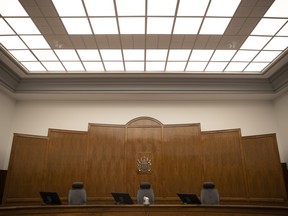The decision highlights that in a circumstantial case, to support a conviction, an accused person’s guilt must be the “only reasonable conclusion available.”

Article content
Saskatchewan’s highest court has overturned a Regina man’s convictions related to drug trafficking because the judges decided it’s possible the cocaine and cash belonged to someone else.
In May of 2020, police received a tip from a confidential source that the man was involved in drug trafficking.
In August of that year, officers began watching him. Their on-and-off surveillance lasted about three months before he was arrested on Nov. 4, 2020.
Advertisement 2
Article content
From there, police proceeded to search two homes. They seized 511 grams of cocaine and around $8,000 in cash from one home on the 700 block of Regina’s Retallack Street and also found $16,945 in a hole in the yard, buried near the back door.
The man who’d been under surveillance was charged and later convicted of possessing the drugs for the purpose of trafficking and for possessing the cash knowing it was obtained by the commission of an offence.
Those convictions have now been overturned and acquittals were entered in their place following a decision by the Saskatchewan Court of Appeal, dated Oct. 22.
The previously-convicted man’s lawyers, Linh Pham and Mervin Nidesh, argued on appeal that the trial judge made mistakes, including failure to find reasonable inferences consistent with their client’s innocence. In this case, that meant failing to find that someone else may have been in possession of what was seized by police.
That is essentially the point on which the appeal turned.
Recommended from Editorial
Article content
Advertisement 3
Article content
The decision of the appeal court — written by Justice Jill Drennan, with Chief Justice Robert Leurer and Justice Catherine Dawson in agreement — references what’s called “constructive possession.”
The decision describes it this way: Constructive possession is established when an accused does not have physical custody of an object but knowingly has it in the actual possession or custody of another person or has it in any place for their own or another’s use or benefit.”
The Crown had argued that the man had possession “principally” because he owned the house and attended the location in the days leading up to his arrest.
The appeal decision states that the trial judge’s conclusion “appears to have” focused on the man having a greater level of control over the house than others who accessed it, “presumably based on his ownership of the property.”
“In my view, on the record before him, the trial judge could not have reasonably arrived at this conclusion,” Drennan wrote.
She noted that some evidence would reasonably “permit” a conclusion that someone else had possession of the drugs and cash. That includes the limited police surveillance and the fact that other individuals such as contractors had access while active construction was underway at the “uninhabitable property.”
Advertisement 4
Article content
There was no physical or forensic evidence linking the previously-convicted man to the seized material, and his indirect ownership of the home through a numbered company “did little to elevate the potential for his possession,” the appeal judge wrote.
Drennan’s written decision added that, in her opinion, to decide the man had a greater level of control over and knowledge of the contents of the home than others was to “conflate the concepts of access and ownership with that of possession.”
The decision notes that the case against the man was a circumstantial one.
A scenario often used to describe circumstantial evidence involves the question of whether it was raining outside. Circumstantial evidence would be a witness testifying they saw someone come in, dripping wet, wearing a raincoat and carrying an umbrella. The witness did not testify they saw it raining, but from their evidence it could be inferred that it was raining outside.
However, in cases turning on circumstantial evidence, a conviction relies on the accused person’s guilt being “the only reasonable conclusion available,” the appeal decision explains.
Advertisement 5
Article content
Drennan wrote that the trial judge provided no explanation for why the “alternate theory” posed by the defence was an unreasonable one.
“To put it bluntly, an assessment of the evidence and absence of evidence points compellingly to at least one inference consistent with innocence.”
The decision later states that this inference would be “that the drugs and cash belonged to another person who had access to the property.”
“It therefore matters not that another reasonable inference consistent with guilt exists on the record,” Drennan wrote.
The Regina Leader-Post has created an Afternoon Headlines newsletter that can be delivered daily to your inbox so you are up to date with the most vital news of the day. Click here to subscribe.
With some online platforms blocking access to the journalism upon which you depend, our website is your destination for up-to-the-minute news, so make sure to bookmark leaderpost.com and sign up for our newsletters so we can keep you informed. Click here to subscribe.
Article content







